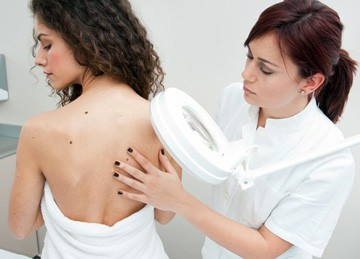Shingles is caused by a reactivation of the virus that causes chickenpox. If you had chickenpox early in life, you can’t get it again, but you can develop the irritation and rash known as shingles when under emotional stress.
Location is Key
The erupted shingles rash usually shows up on one side of your body, but you can also get it on your face. It’s important to note that, while shingles commonly erupt on the torso, you can get shingles anywhere on your body. If you develop shingles in the eye area, you could end up with corneal damage.
Managing the Eruption

The liquid in the bumps of shingles carries the virus. If you have pus from the bumps, make sure to launder all bedding carefully and any clothing you were wearing that may have gotten damp from the secretion. Shower and clean up with a gentle soap to wash away any liquid, then leave the skin exposed to air so the sores can dry out. Using calamine lotion on the tissue that’s weeping can reduce the irritation and pull more fluid out of the sores. Once the weeping stops, avoid putting anything on the bumps so they can scab over, and the outer layer of skin can heal. Handle any fabric or dressings that contain discharge from the blisters with great care. You can spread the virus to others by exposing them to the discharge.
Pain Beyond the Skin
Your skin damage should heal fully within 2 to 4 weeks. However, many people struggle with pain beneath the skin once the flare-up has drained, and the scabs are gone. Once reactivated, the virus can park at the bottom of a nerve and cause shooting pains for months even after the skin eruptions are gone. Many sufferers find relief for this pain with regular application of a shingles cream before dressing and before bed. Nerve pain that leads to muscle spasms can sap your energy and take the joy out of life, so don’t think that the fact that your skin has cleared up requires you to suffer the nerve pain. Visit or call a local pharmacy and invest in a good quality ointment to get your pain under control for a peaceful night’s sleep.
Prevent a Shingles Eruption
 If you’ve had one shingles eruption related to stress, it’s critical not to suffer another. There are antiviral medications you can use to prevent a flare-up, and there is a shingles vaccine that has been extremely effective for some people. Take care to manage stress wisely in your life. Spend time each day exercising to boost your mood. Meditation, or prayer, if you choose, can help calm your mind and reduce the health impacts of anxiety.
If you’ve had one shingles eruption related to stress, it’s critical not to suffer another. There are antiviral medications you can use to prevent a flare-up, and there is a shingles vaccine that has been extremely effective for some people. Take care to manage stress wisely in your life. Spend time each day exercising to boost your mood. Meditation, or prayer, if you choose, can help calm your mind and reduce the health impacts of anxiety.
We live in an uncertain world, but allowing fear to be a constant in your mind and heart will take a toll on your health and wear down your immune system. Protect and boost your immune system with a healthy diet. Incorporate something raw or fresh, either vegetable or fruit, into each meal to boost your vitamin and fiber intake. Add a cup of water to every snack and meal to move food through your digestive system and support the organs that remove toxins from your body. Consider a supplement of B12 vitamins to protect your nerve sheath tissue. Shingles can burn, itch, weep, and hurt. It can either be a burning pain, an itch, or a nerve “zing” at the cellular level. Preventing a flare-up is vital, as is caring for your weeping skin, letting the scabs heal, and managing any subsequent nerve pain.
